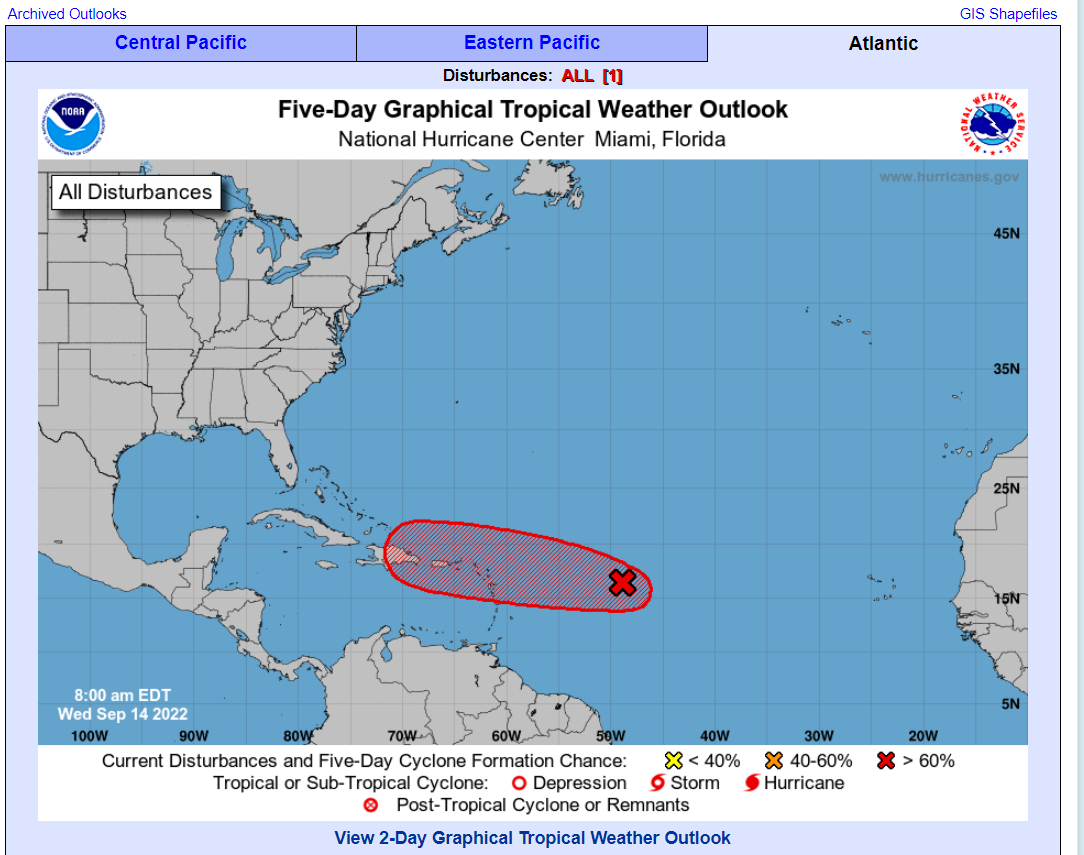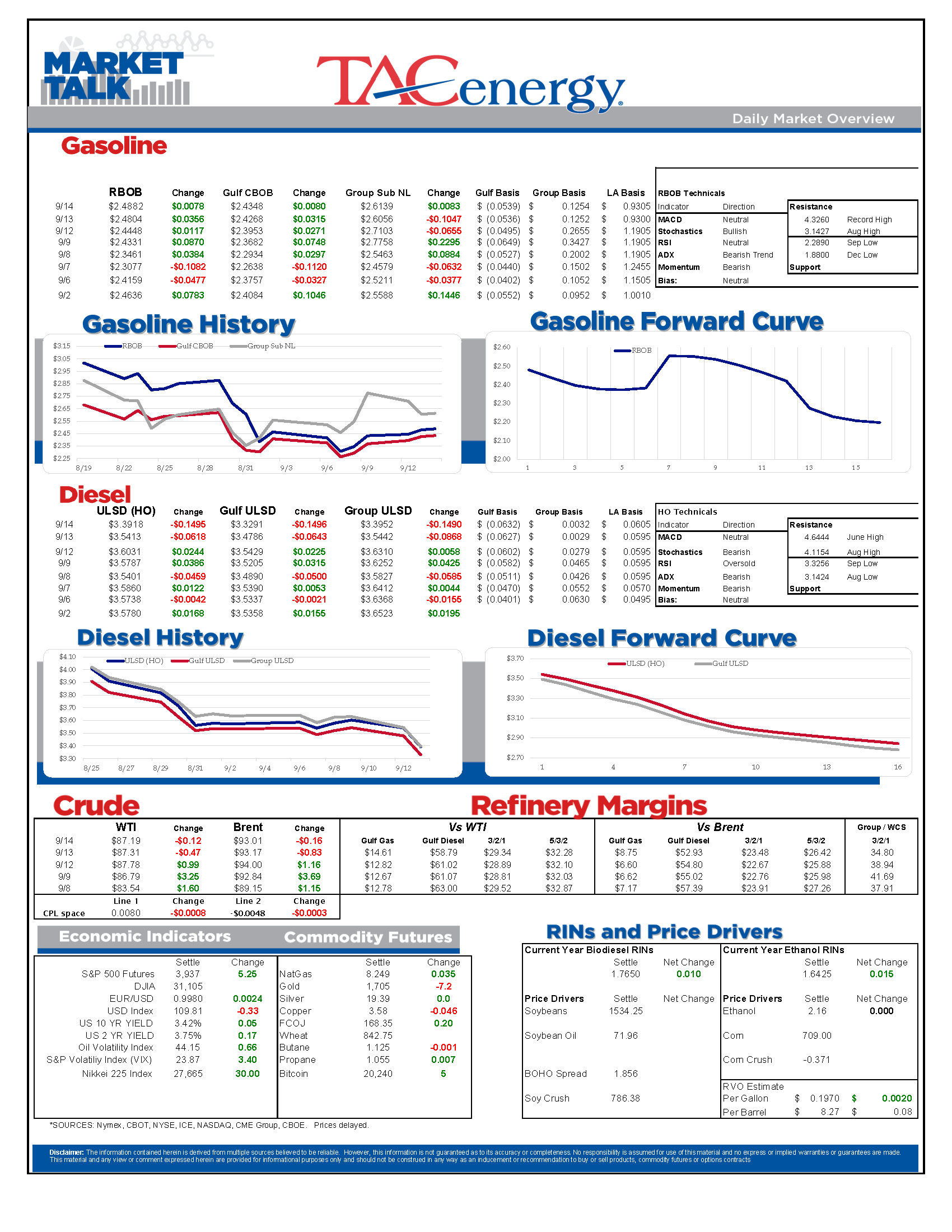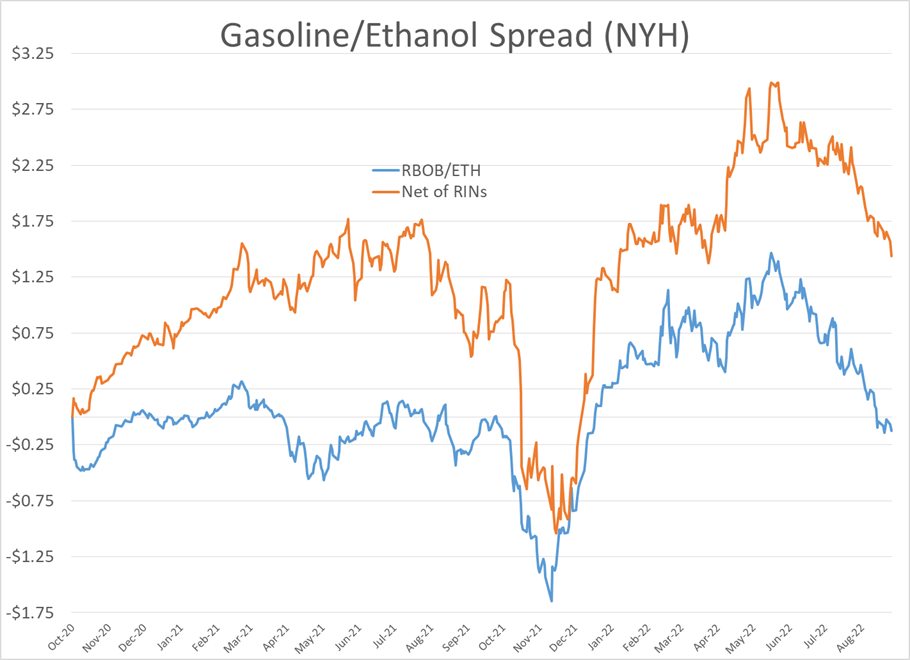Diesel Prices Fell Out Of Bed Wednesday Dropping More Than 20 Cents At One Point To A 5 Week Low

Diesel prices fell out of bed Wednesday dropping more than 20 cents at one point to a 5 week low, even as gasoline and crude prices hold around break even for the day. There’s not a clear reason for the big drop in diesel while WTI and RBOB are neutral, but it appears that recession/demand fears may outweigh supply fears as fuel inventories in the US and abroad show signs of recovery.
US stock markets had their worst day in more than 2 years Tuesday following a discouraging inflation report that doomed hopes of the FED easing up on their plans to raise interest rates and tighten the money supply anytime soon. Diesel prices have had a negative correlation to the S&P 500 in recent months, so it doesn’t seem there’s an immediate connection between the selling in the asset classes, but there’s no denying that a recession would take a heavy toll on distillate demand.
A report by a major US investment bank suggested that European natural gas prices would be cut in half this winter as widespread efforts to solve the Russian energy shortages are proving successful. If that prediction plays out, it suggests a lower need to switch to diesel fuel as a supplemental option for electricity generation.
Ethanol prices have surged this week, alongside corn prices following a bullish crop report from the USDA. Another factor to watch closely in ethanol markets is a looming railroad strike that could hamper the primary transportation method for numerous commodities, including grain alcohol that goes into your fuel tank. The gasoline price vs Ethanol, both gross and net of RIN values, has fallen to its lowest level of the year as gasoline prices have come under pressure while ethanol rebounds.
The potential railroad strike would be a double-edged sword for diesel prices, both reducing the 2nd largest demand source for diesel, while also putting a key supplemental supply source at risk for markets that can’t be fully stocked by pipeline or waterborne options. There is a possibility that some of today’s action in ULSD futures could be related to major railroads unwinding fuel hedges if they now anticipate their actual consumption to be below expected levels, but there’s no way to prove whether or not that’s happening.
The API reported a large build in US commercial crude oil stocks of 6 million barrels last week, but since the SPR was drawn down by more than 8 million barrels, the total oil inventories in the US actually fell again during the week. Distillates increased by 1.7 million barrels while gasoline stocks declined by 3.2 million barrels, which looks like it’s contributing to the big price disparity between products this morning. The EIA’s weekly report is due out at its normal time this morning.
The NHC gives a 70% chance that we’ll see another named storm in the Atlantic this weekend, which would be named Fiona. Most early models show this system turning north and east and avoiding a US Landfall, but a few still leave the door open for this storm to get into the Gulf of Mexico and threaten oil production and refineries, so it can’t be dismissed completely yet.
Click here to download a PDF of today's TACenergy Market Talk.
Latest Posts
Gasoline Futures Are Leading The Way Lower This Morning
The Sell-Off Continues In Energy Markets, RBOB Gasoline Futures Are Now Down Nearly 13 Cents In The Past Two Days
Week 15 - US DOE Inventory Recap
Prices To Lease Space On Colonial’s Main Gasoline Line Continue To Rally This Week
Social Media
News & Views
View All
Gasoline Futures Are Leading The Way Lower This Morning
It was a volatile night for markets around the world as Israel reportedly launched a direct strike against Iran. Many global markets, from equities to currencies to commodities saw big swings as traders initially braced for the worst, then reversed course rapidly once Iran indicated that it was not planning to retaliate. Refined products spiked following the initial reports, with ULSD futures up 11 cents and RBOB up 7 at their highest, only to reverse to losses this morning. Equities saw similar moves in reverse overnight as a flight to safety trade soon gave way to a sigh of relief recovery.
Gasoline futures are leading the way lower this morning, adding to the argument that we may have seen the spring peak in prices a week ago, unless some actual disruption pops up in the coming weeks. The longer term up-trend is still intact and sets a near-term target to the downside roughly 9 cents below current values. ULSD meanwhile is just a nickel away from setting new lows for the year, which would open up a technical trap door for prices to slide another 30 cents as we move towards summer.
A Reuters report this morning suggests that the EPA is ready to announce another temporary waiver of smog-prevention rules that will allow E15 sales this summer as political winds continue to prove stronger than any legitimate environmental agenda. RIN prices had stabilized around 45 cents/RIN for D4 and D6 credits this week and are already trading a penny lower following this report.
Delek’s Big Spring refinery reported maintenance on an FCC unit that would require 3 days of work. That facility, along with several others across TX, have had numerous issues ever since the deep freeze events in 2021 and 2024 did widespread damage. Meanwhile, overnight storms across the Midwest caused at least one terminal to be knocked offline in the St. Louis area, but so far no refinery upsets have been reported.
Meanwhile, in Russia: Refiners are apparently installing anti-drone nets to protect their facilities since apparently their sling shots stopped working.
Click here to download a PDF of today's TACenergy Market Talk.

The Sell-Off Continues In Energy Markets, RBOB Gasoline Futures Are Now Down Nearly 13 Cents In The Past Two Days
The sell-off continues in energy markets. RBOB gasoline futures are now down nearly 13 cents in the past two days, and have fallen 16 cents from a week ago, leading to questions about whether or not we’ve seen the seasonal peak in gasoline prices. ULSD futures are also coming under heavy selling pressure, dropping 15 cents so far this week and are trading at their lowest level since January 3rd.
The drop on the weekly chart certainly takes away the upside momentum for gasoline that still favored a run at the $3 mark just a few days ago, but the longer term up-trend that helped propel a 90-cent increase since mid-December is still intact as long as prices stay above the $2.60 mark for the next week. If diesel prices break below $2.50 there’s a strong possibility that we see another 30 cent price drop in the next couple of weeks.
An unwind of long positions after Iran’s attack on Israel was swatted out of the sky without further escalation (so far anyway) and reports that Russia is resuming refinery runs, both seeming to be contributing factors to the sharp pullback in prices.
Along with the uncertainty about where the next attacks may or may not occur, and if they will have any meaningful impact on supply, come no shortage of rumors about potential SPR releases or how OPEC might respond to the crisis. The only thing that’s certain at this point, is that there’s much more spare capacity for both oil production and refining now than there was 2 years ago, which seems to be helping keep a lid on prices despite so much tension.
In addition, for those that remember the chaos in oil markets 50 years ago sparked by similar events in and around Israel, read this note from the NY Times on why things are different this time around.
The DOE’s weekly status report was largely ignored in the midst of the big sell-off Wednesday, with few noteworthy items in the report.
Diesel demand did see a strong recovery from last week’s throwaway figure that proves the vulnerability of the weekly estimates, particularly the week after a holiday, but that did nothing to slow the sell-off in ULSD futures.
Perhaps the biggest next of the week was that the agency made its seasonal changes to nameplate refining capacity as facilities emerged from their spring maintenance.
PADD 2 saw an increase of 36mb/day, and PADD 3 increased by 72mb/day, both of which set new records for regional capacity. PADD 5 meanwhile continued its slow-motion decline, losing another 30mb/day of capacity as California’s war of attrition against the industry continues. It’s worth noting that given the glacial pace of EIA reporting on the topic, we’re unlikely to see the impact of Rodeo’s conversion in the official numbers until next year.
Speaking of which, if you believe the PADD 5 diesel chart below that suggests the region is running out of the fuel, when in fact there’s an excess in most local markets, you haven’t been paying attention. Gasoline inventories on the West Coast however do appear consistent with reality as less refining output and a lack of resupply options both continue to create headaches for suppliers.







